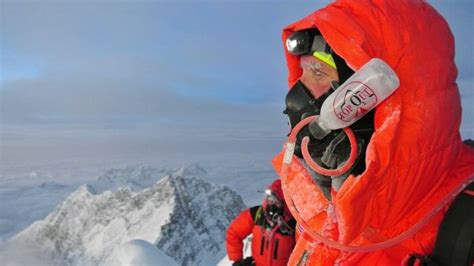
Climbers achieving record-breaking ascents of Mount Everest are increasingly relying on hypoxic tents during their pre-climb preparation to simulate high-altitude conditions, enabling them to acclimatize and improve their performance before even setting foot on the mountain.
Everest Climbers’ Secret Weapon: Hypoxic Tents for Peak Prep
Mount Everest, the world’s highest peak, continues to draw ambitious climbers eager to test their limits and conquer its formidable slopes. While physical fitness and climbing expertise remain crucial, a growing trend among successful Everest climbers involves a “secret weapon” employed long before they reach base camp: hypoxic tents. These specialized tents simulate the oxygen-deprived environment of high altitudes, allowing climbers to pre-acclimatize and significantly enhance their chances of reaching the summit.
The use of hypoxic tents, also known as altitude simulation systems, represents a significant advancement in mountaineering preparation. “These tents reduce the amount of oxygen available in the air, forcing the body to adapt to conditions similar to those found at high altitudes,” explains Dr. Emily Carter, a sports medicine physician specializing in high-altitude physiology. “By spending time in a hypoxic tent before a climb, individuals can stimulate the production of red blood cells, improve their oxygen-carrying capacity, and reduce the risk of altitude sickness.”
The Science Behind Hypoxic Training
The human body responds to reduced oxygen availability (hypoxia) by initiating a cascade of physiological adaptations. The primary response is the increased production of erythropoietin (EPO), a hormone that stimulates the bone marrow to produce more red blood cells. Red blood cells contain hemoglobin, the protein responsible for carrying oxygen throughout the body. With more red blood cells, the body can deliver more oxygen to the muscles and tissues, improving performance at altitude.
Hypoxic tents create this hypoxic environment by either removing oxygen from the air or adding nitrogen to reduce the overall oxygen concentration. Climbers typically spend several hours each day inside the tent, gradually increasing the simulated altitude over a period of weeks or months. “The goal is to mimic the gradual ascent profile of a real climb,” says veteran mountaineer and guide, Jim Davidson. “By the time you arrive at base camp, your body is already partially acclimatized, giving you a significant advantage.”
The benefits of pre-acclimatization extend beyond increased red blood cell production. Hypoxic training can also improve lung function, increase mitochondrial density in muscle cells (enhancing energy production), and improve the body’s ability to buffer lactic acid, reducing muscle fatigue. Studies have shown that climbers who use hypoxic tents experience fewer symptoms of altitude sickness, reach higher altitudes more quickly, and have a greater chance of summiting.
Real-World Impact on Everest Success
The increasing prevalence of hypoxic tent usage among Everest climbers is no coincidence. As competition intensifies and climbers seek every possible advantage, pre-acclimatization has become an almost indispensable part of their training regimen. Many elite climbing expeditions now incorporate hypoxic training as a standard practice.
“In the past, acclimatization was something you did on the mountain itself, which could take weeks and involve multiple rotations between base camp and higher camps,” says veteran climbing guide, Anya Petrova. “Now, climbers can significantly reduce the time spent acclimatizing on the mountain, allowing them to conserve energy and focus on the actual climb.”
However, the use of hypoxic tents is not without its challenges. The cost of purchasing or renting a hypoxic tent system can be significant, making it less accessible to climbers with limited financial resources. Furthermore, spending prolonged periods in a hypoxic environment can be uncomfortable and may lead to side effects such as headaches, fatigue, and nausea. It is crucial to follow a carefully designed acclimatization protocol under the guidance of a qualified medical professional.
The Ethical Considerations
As hypoxic tents become more widespread, questions arise about the ethical implications of using artificial means to enhance performance in mountaineering. Some argue that pre-acclimatization gives climbers an unfair advantage and undermines the spirit of the sport. Others maintain that it is simply a form of advanced preparation that improves safety and reduces the risk of altitude-related illnesses.
“Mountaineering has always involved the use of technology to overcome natural obstacles,” argues Dr. Carter. “From specialized clothing and equipment to supplemental oxygen, climbers have always sought ways to improve their chances of success. Hypoxic tents are simply the latest tool in this evolution.”
The debate over the ethics of pre-acclimatization is likely to continue as technology advances and mountaineering evolves. However, one thing is clear: hypoxic tents are becoming an increasingly important part of Everest climbing, and their impact on the sport is undeniable.
Beyond Everest: Applications in Other Sports and Medicine
The benefits of hypoxic training extend beyond mountaineering. Athletes in various sports, including endurance running, cycling, and swimming, are increasingly using hypoxic tents to improve their performance. By simulating altitude conditions, athletes can stimulate red blood cell production, enhance oxygen uptake, and increase their overall aerobic capacity.
Furthermore, hypoxic therapy is being explored as a potential treatment for various medical conditions, including chronic obstructive pulmonary disease (COPD), heart failure, and sleep apnea. By exposing patients to controlled periods of hypoxia, clinicians hope to improve their lung function, cardiovascular health, and overall quality of life.
The future of hypoxic training and therapy is promising, with ongoing research exploring its potential applications in diverse fields. As our understanding of the body’s response to hypoxia grows, we can expect to see even more innovative uses for this powerful technology.
The Future of Everest Climbing
The integration of hypoxic tents into Everest climbing preparation has undoubtedly changed the landscape of the sport. As technology advances, the line between natural ability and technological enhancement will continue to blur, raising questions about the true nature of achievement in mountaineering. Will future Everest climbs be defined by the climber’s raw skill and endurance, or by their access to the most advanced pre-acclimatization technologies?
The answer to this question remains uncertain, but one thing is clear: the pursuit of Everest’s summit will continue to push the boundaries of human potential and technological innovation. Whether through hypoxic tents, advanced weather forecasting, or other groundbreaking tools, climbers will continue to seek every possible advantage in their quest to conquer the world’s highest peak. The spirit of exploration and the drive to overcome challenges will undoubtedly remain at the heart of Everest climbing, even as the methods and technologies employed continue to evolve.
The Importance of Responsible Implementation
While hypoxic tents offer significant benefits, it is crucial to emphasize the importance of responsible implementation. Climbers should consult with experienced medical professionals and certified trainers to develop a personalized acclimatization plan that takes into account their individual health status, fitness level, and climbing experience. Overdoing hypoxic training can lead to adverse health effects, including pulmonary edema, cerebral edema, and even death.
Furthermore, it is essential to ensure that the hypoxic tent system is properly maintained and operated. Regular calibration and monitoring of oxygen levels are crucial to ensure that the simulated altitude is accurate and safe. Climbers should also be aware of the potential risks of carbon monoxide poisoning if the tent is not properly ventilated.
By following these guidelines, climbers can maximize the benefits of hypoxic tents while minimizing the risks. As with any training tool, proper education, guidance, and responsible use are essential to ensure a safe and successful Everest climb.
The Environmental Impact
The increasing popularity of Everest climbing raises concerns about its environmental impact. The accumulation of trash, human waste, and abandoned equipment on the mountain has become a significant problem, threatening the fragile ecosystem. Furthermore, the use of supplemental oxygen and other resources contributes to the carbon footprint of Everest expeditions.
Climbers and expedition organizers have a responsibility to minimize their environmental impact by following Leave No Trace principles, properly disposing of waste, and using sustainable practices. The use of renewable energy sources, such as solar power, can help reduce the carbon footprint of base camp operations. Collaboration between climbers, local communities, and government agencies is essential to ensure the long-term sustainability of Everest climbing.
A Continuously Evolving Landscape
The story of Everest climbing is one of continuous evolution, driven by technological innovation, changing societal attitudes, and the relentless pursuit of human achievement. Hypoxic tents represent just one chapter in this ongoing saga. As new technologies emerge and our understanding of the human body deepens, we can expect to see even more dramatic changes in the way climbers prepare for and attempt Everest’s summit.
Whether these changes will ultimately enhance the safety, accessibility, or environmental sustainability of Everest climbing remains to be seen. However, one thing is certain: the allure of Everest will continue to inspire and challenge climbers for generations to come, and the quest to conquer the world’s highest peak will continue to push the boundaries of human possibility.
FAQ: Hypoxic Tents and Everest Climbing
1. What exactly is a hypoxic tent and how does it work?
A hypoxic tent, also called an altitude simulation system, is a tent-like enclosure that reduces the amount of oxygen available inside, simulating the oxygen-deprived environment found at high altitudes. This is achieved by either filtering out oxygen from the air or adding nitrogen to decrease the overall oxygen concentration. Climbers sleep or spend several hours each day inside the tent, gradually increasing the simulated altitude to trigger physiological adaptations similar to those that occur during natural acclimatization on a mountain. “These tents reduce the amount of oxygen available in the air, forcing the body to adapt to conditions similar to those found at high altitudes,” explains Dr. Emily Carter.
2. What are the benefits of using a hypoxic tent before climbing Everest?
The primary benefit is pre-acclimatization, which prepares the body for the low-oxygen conditions at high altitudes before even arriving at base camp. This leads to several advantages:
- Increased Red Blood Cell Production: The body produces more erythropoietin (EPO), which stimulates the bone marrow to create more red blood cells, increasing oxygen-carrying capacity.
- Reduced Altitude Sickness: Pre-acclimatization can significantly lessen the symptoms of altitude sickness, such as headaches, nausea, and fatigue.
- Improved Performance: Increased oxygen delivery to muscles and tissues enhances stamina and reduces muscle fatigue.
- Shorter Acclimatization Time on the Mountain: Climbers can spend less time acclimatizing on Everest itself, conserving energy and reducing the overall duration of the expedition.
- Greater Chance of Summit Success: The combination of these benefits leads to a higher likelihood of reaching the summit.
3. Are there any risks or side effects associated with using hypoxic tents?
Yes, there are potential risks and side effects:
- Headaches, Fatigue, and Nausea: Some individuals may experience these symptoms, especially during the initial stages of acclimatization.
- Pulmonary Edema and Cerebral Edema: In rare cases, overdoing hypoxic training can lead to these dangerous conditions, where fluid accumulates in the lungs or brain.
- Carbon Monoxide Poisoning: If the tent is not properly ventilated, there is a risk of carbon monoxide buildup.
- Sleep Disturbances: The hypoxic environment can disrupt sleep patterns.
- Dehydration: It is important to stay adequately hydrated when using a hypoxic tent.
It is crucial to consult with a medical professional and follow a carefully designed acclimatization protocol to minimize these risks.
4. How much does it cost to use a hypoxic tent, and is it accessible to all climbers?
The cost of purchasing or renting a hypoxic tent system can be substantial, ranging from several hundred to several thousands of dollars per month depending on the system’s sophistication and rental duration. This cost can make hypoxic tents less accessible to climbers with limited financial resources. The expense includes the tent itself, the oxygen generator or nitrogen separator, monitoring equipment, and potential consultation fees with medical professionals or trainers. Some climbers may opt to share rental costs or seek sponsorship to access this technology.
5. Are there any ethical concerns about using hypoxic tents in mountaineering?
Yes, there are ongoing ethical debates:
- Fair Advantage: Some argue that pre-acclimatization gives climbers an unfair advantage over those who rely solely on natural acclimatization.
- Undermining the Spirit of the Sport: Critics contend that using artificial means to enhance performance detracts from the inherent challenge and spirit of mountaineering, which traditionally emphasizes physical and mental fortitude in the face of natural obstacles.
- Increased Accessibility: Proponents argue that it enhances safety and democratizes the sport, allowing more individuals to participate by mitigating the risks associated with high altitude. Dr. Carter argues, “Mountaineering has always involved the use of technology to overcome natural obstacles… Hypoxic tents are simply the latest tool in this evolution.”
- Shifting Definition of Achievement: The increasing reliance on technology raises questions about what truly constitutes achievement in mountaineering.
The debate centers on the balance between technological advancement and the core values of mountaineering, such as self-reliance, physical endurance, and respect for the natural environment.









